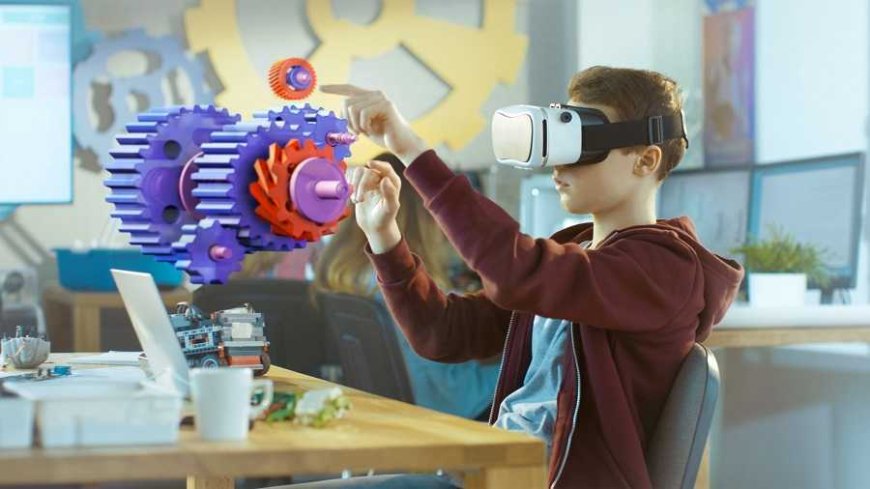The Impact of Virtual Reality on Education Revolutionizing Learning Experiences
Virtual Reality (VR) has emerged as a groundbreaking technology with the potential to revolutionize education.

Virtual Reality (VR) has emerged as a groundbreaking technology with the potential to revolutionize education. By immersing students in realistic, interactive, and engaging virtual environments, VR opens up new avenues for learning and enhances educational experiences. This article explores the impact of virtual reality on education, highlighting its benefits, applications, and challenges.
Enhancing Immersion and Engagement
One of the significant advantages of VR in education is its ability to create immersive learning environments. Traditional teaching methods often struggle to capture students' attention and keep them engaged. However, with VR, students can actively participate in their learning process. By stepping into virtual worlds, they become active participants rather than passive observers. This immersive experience fosters deeper engagement, enhancing knowledge retention and understanding.
Enabling Experiential Learning
Virtual reality enables experiential learning by simulating real-world scenarios and providing hands-on experiences. For example, VR can transport students to historical landmarks, ancient civilizations, or even outer space, allowing them to explore and interact with these environments. Medical students can practice surgeries in virtual operating rooms, and engineering students can simulate complex engineering projects. By bridging the gap between theory and practice, VR promotes experiential learning, which has been proven to be highly effective in knowledge acquisition.
Facilitating Visual and Kinesthetic Learning
Visual and kinesthetic learners often struggle with traditional teaching methods that heavily rely on auditory instruction. VR offers a solution by providing visual and interactive learning experiences. Students can visualize complex concepts, observe processes in action, and manipulate objects in virtual environments. This multi-sensory approach caters to diverse learning styles, making education more accessible and effective for all students.
Fostering Collaboration and Interaction
Virtual reality fosters collaboration and interaction among students and teachers, regardless of their physical location. Through VR platforms, students can connect and collaborate with peers from around the world, sharing knowledge and working together on projects. Teachers can guide and support students in real-time, providing immediate feedback and personalized instruction. The collaborative nature of VR encourages teamwork, communication skills, and global perspectives, preparing students for the interconnected world.
Overcoming Accessibility Barriers
VR has the potential to bridge accessibility gaps in education. Students with physical disabilities or limitations can experience virtual environments that may otherwise be inaccessible to them. For example, students with mobility impairments can explore archaeological sites or natural wonders through VR. Additionally, students from remote areas or underprivileged backgrounds can access quality education and resources through virtual platforms, leveling the playing field and promoting equity in education.
Challenges and Future Considerations
While virtual reality holds immense promise for education, it also presents challenges that need to be addressed. The cost of VR equipment, limited content availability, and the need for technical expertise are some of the barriers schools and institutions may face when implementing VR. Furthermore, ensuring the quality and effectiveness of VR educational content requires careful curation and development.
To maximize the impact of VR on education, ongoing research, collaboration between educators and VR developers, and investment in infrastructure are crucial. As the technology continues to evolve, advancements such as haptic feedback, eye-tracking, and AI integration can further enhance the educational potential of VR.
Moreover, the impact of virtual reality on education extends beyond traditional classroom settings. Distance learning and online education have become increasingly prevalent, especially in the wake of global events like the COVID-19 pandemic. VR offers a unique solution to enhance remote learning experiences. By utilizing VR headsets and platforms, students can attend virtual classrooms, engage in interactive lectures, and collaborate with fellow students in a simulated environment that closely resembles physical classrooms. This helps to recreate the sense of presence and social interaction that is often lacking in online learning, making remote education more engaging and effective.
Additionally, virtual reality can be applied to specialized fields of study that require practical training and exposure. For instance, flight simulators have long been used to train pilots, but with VR, aspiring pilots can experience highly realistic and cost-effective flight simulations without the need for physical aircraft. Similarly, VR can be utilized in vocational training, where students can practice tasks and procedures in a safe and controlled virtual environment, reducing risks and costs associated with real-world training.
As virtual reality continues to evolve and become more accessible, its impact on education is poised to grow even further. Educational institutions, policymakers, and technology developers need to collaborate to address challenges, such as cost, content development, and teacher training, to fully harness the potential of VR in education. By embracing virtual reality, we can transform the way knowledge is imparted, enriching educational experiences and empowering students to become lifelong learners in the digital age.
